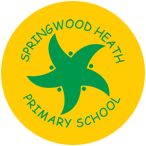| Intent – Reading
At Springwood Heath we ensure that reading is our priority. Through reading in particular, pupils have a chance to develop culturally, emotionally, intellectually, socially, and spiritually. The teaching of English and implementation of reading strategies is embedded across our curriculum. In line with the national curriculum, we ensure that all pupils:
Dedicated events such as World Book Day, author events, reading initiatives, organised through the Liverpool Learning Partnership, and class assemblies are part of our core offer and enrich our love of reading, writing and performing literature. |
|
|||
| At Springwood Heath, we teach reading through Steps to Read. Through this we ensure that we provide whole class Shared Reading through carefully crafted units of work. Curriculum knowledge for foundation subjects is also provided through the planning. By using high-quality fiction, non-fiction, and poetry books, we ensure that we teach all aspects of the national Curriculum.
Step to Read is: • sequenced, coherent and progressive • uses language-rich texts for vocabulary teaching • includes all elements of comprehension, taught sequentially across an academic year • has a clear focus on the skills and strategies needed to be a proficient and confident reader • uses engaging texts to promote a life-long love of reading • includes poetry, non-fiction and fiction that enhances learning across the curriculum. |
|
|||
| Implementation (Overviews) Reading | ||||
| Early Years
It is crucial for children to develop a life-long love of reading. Reading consists of two dimensions: language comprehension and word reading. Language comprehension (necessary for both reading and writing) starts from birth. It only develops when adults talk with children about the world around them and the books (stories and non-fiction) they read with them, and enjoy rhymes, poems, and songs together. We use Read Write Inc as structured programme for phonics. Skilled word reading, taught later, involves both the speedy working out of the pronunciation of unfamiliar printed words (decoding) and the speedy recognition of familiar printed words. Writing involves transcription and composition (articulating ideas and structuring them in speech, before writing). |
|
|||
| KS1 | ||||
| In KS1, we follow Steps to Read alongside our phonic programme: Read Write Inc.
Year 1 Planning Sequence Year 2 Planning Sequence |
||||
| Lower KS2 | ||||
| Year 3 Planning Sequence
Year 4 Planning Sequence |
|
|||
| Upper KS2Y5
Y6 |
|
|||
| Lesson Design | ||||
| Steps to Read provides a clear teaching sequence to reading sessions that explicitly teach reading skills in a cumulative way through evidence-based approaches. The comprehensive units have been constructed so that the entire statutory curriculum for reading is covered from EYFS to Y6.
Lessons follow the evidenced-based approach of: Teacher Read, Teacher Model, Children Practise and Children Apply. |
||||
| Mapping of Knowledge within a unit
Steps to Read units cover either 4 or 5 weeks. The fifth lesson of each week – an extended application session – provides an opportunity for children to apply the skills they have gained in the previous 4 sessions. |
||||
| Impact
How do we know what children have learnt |
||||
| The Reading Assessment Counts document aids teachers in gaining a deeper understanding of each standard within a year group and the progress children are making across the year. It assists teachers in identifying gaps in learning and therefore informs planning. The impact of our English curriculum is a community of enthusiastic readers and writers who can readily and successfully demonstrate their reading skills across the curriculum. Children are confident when encountering new vocabulary in their reading and include it in their writing. Pupils support one another in their discussions and peer-review each other’s work. Pupils demonstrating greater depth understanding will make deeper inferences and use their own experiences to make accurate and likely predictions. Children will approach new texts confidently and will demonstrate their learning of the whole range of year group objectives through questions posed about the text. |
Newsletters
28th February 2025
Friday 14th February
Friday 7th February
17th January 2025
What's On
- No events coming up!







